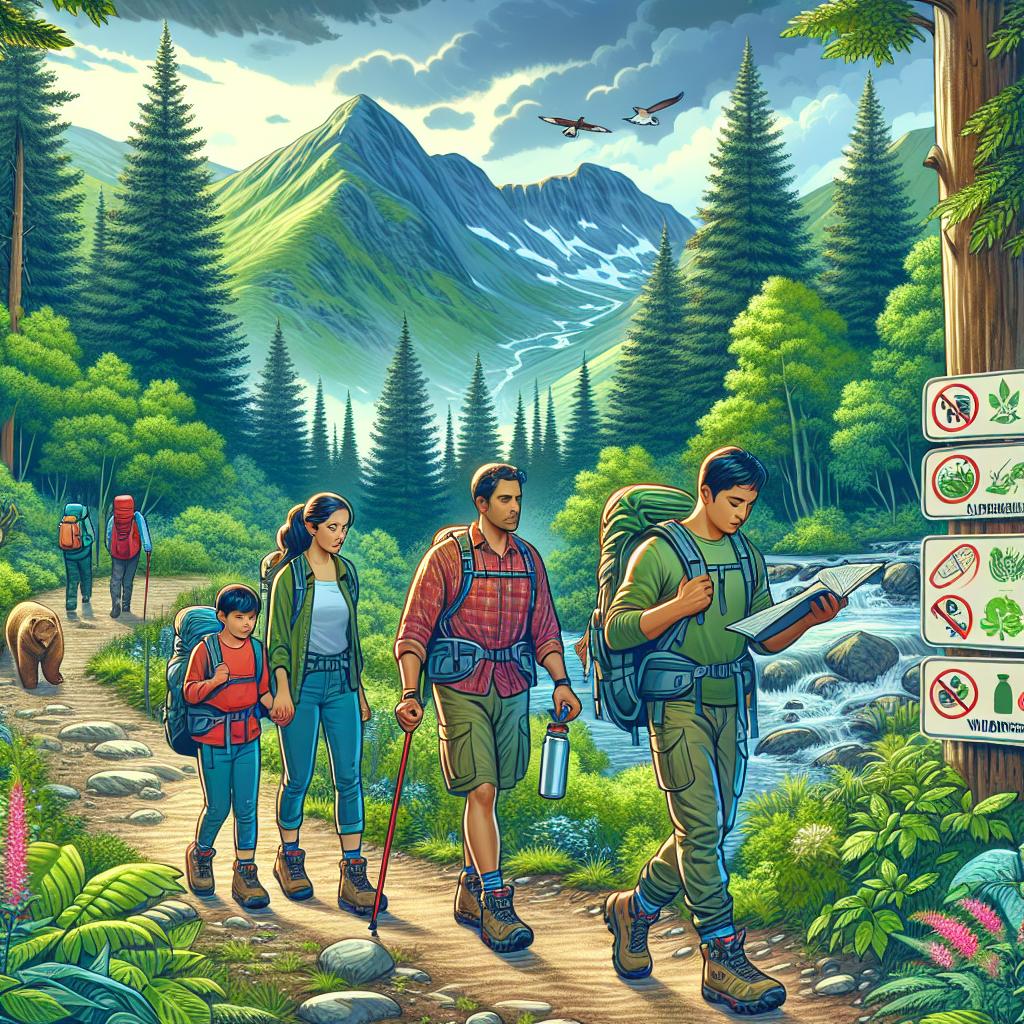Nestled between the borders of North Carolina and Tennessee lies a realm where nature whispers ancient stories and every footfall carries you deeper into an unspoiled world. The Great Smoky Mountains, cloaked in a perpetual mist and echoing with the voices of diverse wildlife, beckon adventurers to explore their majestic backcountry trails. Whether you are an intrepid hiker seeking solitude or a casual wanderer eager to embrace the splendor of the wilderness, navigating these trails can be both exhilarating and a test of your wits. This article aims to guide you through the best ways to traverse these enchanting paths, ensuring your journey through the Smokies is as memorable as it is enjoyable. Strap on your boots, hoist your backpack, and let’s embark on an odyssey through the heart of nature’s grandeur.
Preparation Meets Adventure: Researching Trails and Understanding Terrain
To prepare for an adventure through the Smoky Mountains, a deep dive into researching trails and understanding the terrain is essential. Begin by identifying trails suitable for your skill level and duration of hike. The Smokies boast a diverse array of trails, ranging from beginner-friendly paths to challenging backcountry treks. A well-researched trip can help you avoid unexpected hurdles. Utilize resources like AllTrails, National Park Service maps, and local hiking forums. These platforms offer invaluable insights about trail conditions, elevation changes, and other hikers’ experiences. Additionally, paying attention to seasonal changes is crucial as the trails in the Smokies can transform dramatically with the weather.
Equipment and gear play a vital role in your adventure. Make sure to pack appropriately according to trail difficulty and weather forecast. Here’s a quick checklist of essentials:
- High-quality Hiking Boots – for tackling rugged terrain
- Layered Clothing – to adjust to fluctuating mountain temperatures
- Navigation Tools – map, compass, and a fully charged GPS
- Trail Snacks and Water – to keep your energy levels up
- First-aid Kit – always be prepared for minor injuries
| Trail Name | Difficulty | Length (Miles) | Elevation Gain (Feet) |
|---|---|---|---|
| Alum Cave Trail | Moderate | 4.4 | 1,125 |
| Charlies Bunion | Strenuous | 8.0 | 1,640 |
| Cades Cove Loop | Easy | 11.0 | 200 |

Packing Essentials: Gear and Supplies for a Safe and Enjoyable Journey
Before embarking on your adventure through the Smoky Mountains, it’s essential to ensure you have the right gear and supplies for a safe and memorable hike. Start with a reliable backpack that is both lightweight and comfortable. Make sure it has multiple compartments to help you organize your essentials. Speaking of essentials, having a topographic map of the trails and a compass will keep you oriented, especially in areas where GPS signals may be weak. Don’t forget a headlamp with extra batteries in case you end up hiking longer than expected. A water filtration system or purification tablets can be lifesavers when fresh water is limited.
What you wear plays a critical role in your hiking experience. Opt for moisture-wicking clothing to keep you dry, even when you’re sweating, and layer up with a lightweight, waterproof jacket to protect against sudden changes in weather. Sturdy hiking boots with good ankle support are indispensable for navigating rocky or uneven terrains. Here’s a handy table to summarize key clothing items:
| Clothing Item | Purpose |
|---|---|
| Moisture-Wicking Shirt | Keep you dry and comfortable |
| Lightweight Waterproof Jacket | Protection from rain and wind |
| Sturdy Hiking Boots | Support and traction |
| Thermal Socks | Keep feet warm |
Additional items worth packing include:
- First-aid kit for minor injuries
- Multi-tool for a variety of tasks
- Fire starter for emergencies
- Sunscreen and sunglasses for UV protection
- Nutritious snacks for sustained energy

Navigating with Confidence: Maps, GPS, and Trail Markers
Whether you’re a seasoned hiker or an enthusiastic newbie, knowing how to utilize maps, GPS devices, and trail markers is essential for a safe and enjoyable trek through the Smoky Mountains. Start with a detailed topographic map, which offers invaluable information about terrain, elevation, and landmarks. If digital is more your style, a reliable GPS device or smartphone app with offline maps is indispensable. Just remember, technology can fail, so always carry a physical map as a backup.
Trail markers, the trusty breadcrumbs of the wilderness, guide you from trailhead to summit. You’ll find an assortment of markers including blazes (paint marks on trees), cairns (stone stacks), and signposts. Each one serves as a reassurance that you’re heading in the right direction. Keep an eye out for intersections and always verify your route promptly. Here’s a quick reference guide to help you:
| Marker Type | Description | Example |
|---|---|---|
| Blazes | Painted strips on trees |  |
| Cairns | Stacked stones |  |
| Signposts | Wooden/metal signs |  |
Quick Tips:
– Always cross-check digital and physical maps.
– Ensure GPS batteries are fully charged.
– Familiarize yourself with local trail markers before setting out.

Respect and Conservation: Leave No Trace Principles for Backcountry Hiking
Preserving the pristine beauty of the Smoky Mountains relies heavily on practicing Leave No Trace principles. Here are key guidelines to remember:
- Plan Ahead: Research the trails and understand the regulations specific to the Smokies. Know your route and carry a map to avoid getting lost.
- Travel and Camp on Durable Surfaces: Stick to marked trails and designated campsites to prevent erosion and avoid damaging the wildlife habitat.
- Minimize Campfire Impact: Use a portable stove for cooking and a lantern for light instead of building open fires which can scar the landscape.
- Pack It In, Pack It Out: Carry all your waste out with you. This includes food wrappers, hygiene products, and biodegradable items.
Wildlife and natural settings are your companions on backcountry hikes. Ensuring their protection enhances your experience:
- Respect Wildlife: Observe animals from a distance without disturbing them or their habitats. Do not feed wildlife as it can disrupt their natural behavior.
- Be Considerate of Other Visitors: Maintain a quiet presence, stay on the trail, and yield to others. Respect their experience as much as you respect nature.
| Principle | Action |
|---|---|
| Plan Ahead | Carry a map, know regulations |
| Camp on Durable Surfaces | Use marked trails and sites |
| Minimize Campfire Impact | Use portable stoves and lanterns |
| Pack It In, Pack It Out | Carry all waste out |
| Respect Wildlife | Observe from a distance, no feeding |
| Be Considerate | Maintain quiet, yield to others |
Q&A
Q: What are the primary considerations for safely navigating backcountry hiking trails in the Smoky Mountains?
A: When exploring the backcountry hiking trails in the Smoky Mountains, safety and preparation are paramount. Key considerations include understanding trail difficulty, weather conditions, and terrain. It’s essential to bring a detailed map and compass, as GPS signals can be unreliable. Pack appropriate clothing, sturdy footwear, ample water, and high-energy snacks. Inform someone of your itinerary and expected return time, and always be prepared for sudden changes in weather.
Q: Are there specific trails in the Smoky Mountains recommended for beginners?
A: Yes, the Smoky Mountains offer several beginner-friendly trails. One popular choice is the Laurel Falls Trail, a relatively short and paved path that leads to a beautiful waterfall. The Porters Creek Trail is another good option, featuring gentle inclines and scenic views of wildflowers, historic sites, and rushing streams.
Q: How should one prepare for the potential wildlife encounters on these trails?
A: Encountering wildlife is a common experience in the Smoky Mountains, so preparation is key. To minimize risks, maintain a safe distance from all animals and never feed them. Carry Bear Spray and know how to use it, especially in bear-active areas. Make noise while hiking to avoid surprising animals, and store food securely to prevent attracting wildlife to campsites.
Q: What are the best times of year for backcountry hiking in the Smoky Mountains?
A: The best times for backcountry hiking in the Smoky Mountains are typically during the spring and fall. These seasons offer cooler temperatures, stunning fall foliage or spring wildflowers, and fewer crowds compared to summer. During winter, trails can be icy and more challenging, requiring extra caution and gear.
Q: What steps should be taken if one gets lost on the trails?
A: If you find yourself lost on the trails, remain calm and avoid wandering further off trail. Refer to your map and compass to reorient yourself. If you’re unable to determine your location, find a safe spot and make yourself visible for search and rescue teams. Signal your presence with a whistle, bright clothing, or a fire if safe to do so.
Q: Do the Smoky Mountains National Park authorities offer any resources for backcountry hikers?
A: Yes, the park authorities provide various resources for backcountry hikers, including detailed trail guides, maps, and safety information. They also offer a backcountry permit system that ensures hikers are informed and their travels are monitored for safety. Rangers are available to answer questions and provide current trail conditions and advice.
Q: How does one acquire a backcountry permit, and why is it necessary?
A: Backcountry permits can be acquired online through the Smoky Mountains National Park website or at designated visitor centers. These permits are necessary for overnight stays in the backcountry to manage trail use, ensure safety, and preserve the natural environment. Permits also provide a record of your plans, which is crucial in case of emergencies.
Closing Remarks
As the misty silhouettes of the Smoky Mountains fade into the twilight, one thing becomes beautifully clear: the true essence of backcountry hiking lies in the journey itself. From the tranquil whispers of old-growth forests to the invigorating ascent of rugged peaks, each trail offers an intimate dance with nature’s grandeur. Whether your compass is guided by a seasoned map or the intuitive nudge of a hiker’s heart, the Smokies await with secrets only known to the wandering soul. Equip yourself wisely, tread softly, and let the trails unveil their timeless stories. As each step carries you deeper into the wild embrace of these storied mountains, remember this: the path, much like the experience, is yours to shape, honor, and cherish. Until the next adventure calls, may your trails be ever winding and your spirit perpetually free.

